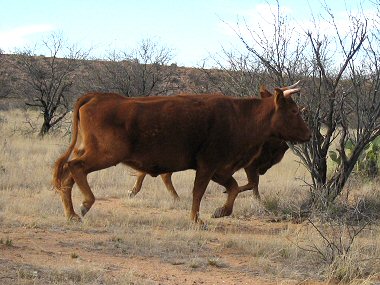| |
Cattle
 |
 |
 |
|
|
| No description of southwest fauna would
be complete without cattle, these non-native species are probably the
most prevalent mammal in the southwest backcountry. The word cattle is
typically used to describe the domesticated species of this ruminant
mammal. Most cattle have unbranched horns consisting of a horny layer
surrounding a bone extension of the skull; these horns, unlike those of
deer, are not shed. Some cattle are naturally hornless. |
| |
 |
History of
Cattle Grazing |
 |
|
One of the most significant changes affecting the ecosystem of the
Southwest has been the widespread introduction of domestic livestock. Cattle
were initially brought to the area by the Spanish in the late 1500s, however,
the animals only began to have a significant impact on the region with the
arrival of the railroads in the late 1800s. By 1890, hundreds of thousands of cattle
were grazing on public lands in sensitive desert and riparian areas throughout
the region.
of the railroads in the late 1800s. By 1890, hundreds of thousands of cattle
were grazing on public lands in sensitive desert and riparian areas throughout
the region.
|
In Arizona, more than 87% percent of the
14.2 million acres managed by the Bureau of Land Management (BLM) are
grazed by livestock while the Forest Service permits grazing on more than
67% of the 11.2 million acres they manage. |
By the time President Theodore Roosevelt had created federal
forest reserves in the west in the 1890s, ranchers had already become
accustomed to unregulated use of public lands as range for livestock. By 1900,
cattle had found their way into the most remote, timbered and mountainous areas
and as a result, many areas had been seriously degraded, after less than a
single generation of use. Almost one hundred years later, the effects of
intense grazing in the latter part of the 19th century can still be readily
seen in many parts of the Southwest. |
| |
 |
Environmental Consequences |
 |
|
| Anyone who has spent any time on this web
site probably knows that I'm not a big fan of cattle grazing on public
lands. Spend some time following the hikes on this site and you'll see
again and again the heartbreaking evidence and widespread damage these
creatures have inflicted upon our delicate desert ecosystems. Want to do
something? A practical step that everyone can
take is to reduce or eliminate beef from your diet, it's bad for you
anyway. |
A few grazing facts: |
- As a result of being consumed beyond their ability to
renew themselves, vegetation is disappearing from desert ranges, to be
replaced by unpalatable weeds, thorny shrubs and unproductive woodlands as
well as by exotic, non-native species.
- A 1994 U.S. Forest Service report concluded that livestock
grazing was the 4th major cause of overall species endangerment and the 2nd
major cause of plant endangerment.
- Riparian areas are vital to the survival of all kinds of
wildlife in the water-poor West. These areas are being harmed as
livestock reduce or eliminate streamside vegetation, trample banks,
and degrade water quality. In fact,
grazing has damaged 80% of western streams and riparian areas in the U.S.
- Erosion is estimated to be robbing millions of acres of
public lands of valuable topsoil. Cattle can denude land of vegetation
causing greater soil erosion and they can compact soils with their hooves
resulting in reduced water infiltration.
- Each year taxpayers subsidize approximately $100 million
to support grazing on public lands, yet only 1.4% of U.S. cattle producers
ranch on Western BLM and Forest Service lands.
|
|
Below are some grazing resources and organizations working to
improve grazing practices in the Southwest: |
|
|
Back to Flora & Fauna |
|

